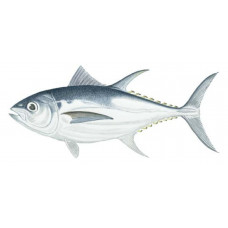Latin name
Thunnus obesus
Other names
Bigeyed tuna, bigeye tunny; French: patudo, thon obèse; Hawaiian: ahi; Indonesian: taguw, tongkol; Italian: tonno obeso; Japanese: mebachi, mebuto; Portuguese: albacora bandolim, atum patudo, patudo; Spanish: albacora, atún ojo grande, patudo
Identification
This species is characterized by a stocky body and large eyes. As a rule, there are no special markings on the body, but some specimens may have vertical rows of whitish spots on the abdomen. The first dorsal fin is dark yellow. The second dorsal fin and anal fin are blackish brown or yellow and may be bordered in black. The fins are bright yellow with narrow black edges. The tail does not have the white edge as in albacore. The pectoral fins can reach the second dorsal fin. The second dorsal fin and anal fin never go as far back as the large yellowfin tuna. It has a total of 23 to 31 gill edges on the first arch. The liver margin is striped. The two dorsal fins are closely spaced, the first has 13–14 spines, the second has 14–16 rays. The anal fin has 11 to 15 rays. On either side of the caudal fin is a strong lateral keel between two small keels, which are located slightly further back on the tail. The swim bladder is present.
Distribution
Widespread in all oceans between 40-45°N and 40°S. Absent in the Mediterranean Sea. This schooling, pelagic, seasonally migrating species, inhabiting warm temperate waters of the Atlantic, Indian and Pacific Oceans, presumably makes rather extensive migrations.
Habitat
Oceanic species of tropical and subtropical regions. Occurs from the ocean surface to depths of 300 m or more. Flocks of bigeye tuna usually stay at depth during the day.
Size
Bigeyes are usually found between 16 and 67 inches long, but can reach as much as 75 inches. The world record for all tackle is considered to be a 435-pound fish caught off the coast of Peru in 1957. Bigeye tuna live 10 years or more. It is over 200 cm long and weighs more than 100 kg. An individual 236 cm long had a mass of 197.3 kg. At the end of the first year of life, the length reaches 60 cm, by the end of the second year - 100 cm, then the growth slows down a bit. It becomes sexually mature at the end of the second or beginning of the third year of life at a length of 100-110 cm.
Life history and Behavior
Bigeye tuna reach sexual maturity at about 40–50 inches in length and spawn at least twice a year. This occurs throughout the year in tropical waters, peaking during the summer months.
Food and feeding habits
The food items are quite diverse. By mass in the tuna diet, fish rank first, followed by cephalopod mollusks. The diet of bigeyes includes squid, crustaceans, mullet, sardines, small mackerel and some deep-water species. They often stay in deeper water, especially during the day, and, unlike other tuna, rarely chase bait fish near the surface.
Reproduction
In the breeding areas, the surface water temperature is about 27-30°С. Due to the non-simultaneous maturation of sexual products, spawning is very prolonged and can take place year-round. Spawning peaks south of the equator in February-April and north of the equator in July-September. Absolute individual fecundity varies from 1.5 to 9.0 million eggs. Development are portioned, hatching of sexual products in batches occurs at intervals not exceeding a month. The size of the oocytes ready to hatch varies from 0.7 to 0.9 mm. Caviar development occurs in the subsurface layer of the ocean at a surface temperature of 23 °C, hatching fetuses after about 20 hours. The length of hatched larvae is about 1.5 mm.
| Classification | |
| Phylum | Chordata |
| Class | Actinopterygii |
| Squad | Scombriformes |
| Family | Scombridae |
| Genus | Thunnus |
| Species | T. obesus |
| Features | |
| Conservation status | Vulnerable |
| Habitat | Pelagic |
| Life span, years | 16 |
| Maximum body weight, kg | 178 |
| Maximum length, cm | 250 |
| Sailing speed, m/s | No information |
| Threat to people | Edible |
| Way of eating | Predator |



